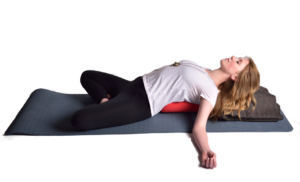
Matsyasana (Fish Pose) is one of yoga’s traditional poses. Because it expands the chest and throat, it is often practiced as a counter pose to Sarvangasana (Shoulderstand).
In the traditional version of Matsyasana, the neck is placed in extreme extension as you bend the neck back and place the top of the head on the floor. I no longer teach the full version of this pose. In my opinion, it is difficult for most people to do it safely. Extreme extension of the neck, coupled with pressure on the the cervical spine, often causes dizziness or nausea, and could, in extreme cases, cause stroke.
The supported version carries none of these risks. In fact, it’s a favorite among all my students, a much needed release for computer-weary necks and shoulders. Supported Matsyasana expands the chest and can relieve neck and shoulder tension.
How to Practice Supported Fish Pose
- Place a Junior Bolster lengthwise on your Yoga Mat. You can also use two firm Yoga Blankets folded in a long, narrow rectangle and stacked so that they are five to six inches high. Place your bolster or blanket stack lengthwise on your mat.
- Sit in front of your bolster, blanket stack or blocks so that your pelvis is eight to ten inches in front of them. Then lean back onto your props so that your lower ribs rest against the front edge.
- In general the pose is most comfortable when your chin is even with or slightly lower than your forehead. If your head is tilting back, this pose will get uncomfortable fairly quickly. You can remedy this by placing a folded blanket under your head and neck to elevate them. Make sure that your head support is under your neck as well. This pose should be comfortable. Use as much height under your head as you need in order to feel relaxed.
- Now settle your torso down onto your bolster, letting your arms rest at about a 45-degree angle and turning your palms upward.
- Relax and breathe deeply for at least a minute. You can stay in this pose as long as it’s comfortable, even as long as 10-15 minutes. Most of us spend so much time in the opposite position—bent over a keyboard—that there’s probably little chance of overdoing Supported Matsyasana.
- To come out of Supported Matsyasana, roll gently off your bolster, onto your side. Take a few breaths on your side before pushing yourself up to sitting.
